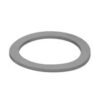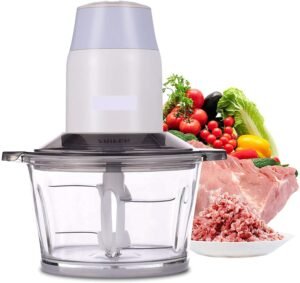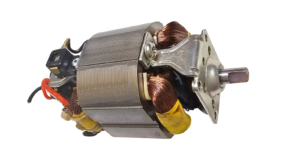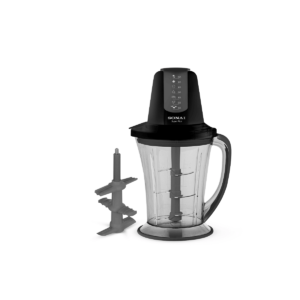Blender Choppers Gaskets/O-Rings
₹234.00 Original price was: ₹234.00.₹195.00Current price is: ₹195.00.
Understanding Gaskets and O-Rings
Gaskets and O-rings are critical components in various mechanical assemblies, including blender choppers. A gasket is a flat sealing element, typically made from materials such as rubber, silicone, or cork, designed to fill the space between two or more surfaces to prevent leakage of fluids or gases. The primary function of gaskets in blender choppers is to ensure a watertight seal between the container and the blades during operation, which is vital for maintaining performance and safety.
On the other hand, an O-ring is a circular sealing device, characterized by its toroidal shape. O-rings are commonly made from similar materials as gaskets, such as nitrile rubber or fluorocarbon, and serve a primary function in creating a seal in cylindrical surfaces. In the context of blender choppers, O-rings are often used to seal the connection between the motor assembly and the blending container, effectively preventing leakage at higher pressures generated during blending.
While both gaskets and O-rings serve to prevent leaks, the choice between them depends on their applications and the specific design of the blender chopper. Gaskets are effective in sealing larger gaps and uneven surfaces, making them suitable for holding together two flat surfaces. Conversely, O-rings provide an efficient seal in dynamic applications where movement is involved, thanks to their elasticity. Understanding when to use gaskets or O-rings is important for effective maintenance and repair of blender choppers, ensuring the appliance operates efficiently and extends its lifespan.
Common Issues Faced with Blender Gaskets and O-Rings
Blender choppers are essential kitchen appliances, and their efficiency often hinges on the state of their gaskets and O-rings. These components serve a crucial role in ensuring a tight seal, preventing leaks, and maintaining optimal blending conditions. Unfortunately, several common issues can arise with these parts over time, which can compromise their effectiveness and the overall performance of the blender.
One of the primary concerns is wear and tear. Frequent use of the blender naturally leads to physical degradation of gaskets and O-rings. The friction from regular blending operations can cause these components to lose their elasticity, resulting in a less reliable seal. This wear can often be identified by visible cracks or deformation in the gaskets or O-rings, indicating that they may need replacement to restore the blender’s functionality.
Another significant issue is deterioration due to heat or exposure to various ingredients. Many blenders are designed to handle hot liquids and thick mixtures, yet prolonged exposure to extreme temperatures or acidic substances can hasten the breakdown of these components. Users should inspect their gaskets and O-rings routinely for signs of chemical erosion or warping caused by high temperatures, as this can lead to leaks during blending and ineffective operation.
Moreover, the effectiveness of gaskets and O-rings may diminish over time, even without visible signs of damage. Such deterioration results in diminished performance during the blending process, which can manifest as reduced suction and potential leakage. Neglecting these issues can lead to more serious problems such as leaks that not only affect food preparation but also may cause damage to the appliance itself. Regular maintenance, including inspection and timely replacement, is vital for ensuring the longevity and efficiency of blender choppers.
How to Properly Maintain Gaskets and O-Rings
Maintaining gaskets and O-rings is crucial for ensuring the longevity and optimal performance of blender choppers. These components form essential seals, preventing leaks and ensuring efficient operation. Regular maintenance can significantly extend their lifespan, requiring minimal effort and adherence to best practices.
First and foremost, cleaning is vital. After each use, it is important to detach the gaskets and O-rings from the blender chopper. Rinse them thoroughly under warm water, using a mild detergent if necessary. Avoid abrasive cleaners or scrubbers, as these can cause damage to the surface of the gaskets and O-rings. For stubborn residues, a soft cloth or sponge should suffice. After cleaning, ensure that they are completely dry before reassembly to prevent traps of moisture that could lead to deterioration.
Storage is another critical aspect of maintenance. Gaskets and O-rings should be stored in a cool, dry place away from direct sunlight. Prolonged exposure to heat and UV light can cause these components to harden or crack. It is advisable to keep them in sealed bags or containers to avoid contamination from dust and debris.
Inspecting gaskets and O-rings regularly is essential to catch any signs of wear and tear. Look for cracks, deformation, or a hardened texture. If any of these signs are present, the affected seal should be replaced promptly to avoid leaks. Incorporating routine checks into your maintenance schedule can facilitate early detection of these issues.
Furthermore, avoid common mistakes such as over-tightening components, which can compress gaskets and O-rings excessively, leading to premature failure. Ensuring proper alignment during assembly is also crucial to maintain a secure and effective seal. By following these maintenance practices, users can promote the longevity of gaskets and O-rings, thereby maintaining the efficiency of blender choppers.
When to Replace Gaskets and O-Rings
Gaskets and O-rings are crucial components of blender choppers, ensuring a tight seal that prevents leaks and maintains optimal performance. However, over time, these parts may wear out and require replacement. Identifying the right moment for this action can prolong the life of your blender and enhance its efficiency.
One of the primary indicators that a gasket or O-ring needs replacement is the presence of leaks during operation. If you notice liquid escaping from the blender’s base or around the blade assembly, it is a clear sign that the sealing components are failing. These leaks not only create messes but can also impact the performance and safety of the blender. Similarly, unusual noises during blending, such as grinding or rattling sounds, may indicate that the O-ring or gasket has deteriorated, resulting in improper sealing.
Another important factor to consider is the age of the blender and the frequency of its use. Regular use can accelerate wear and tear on gaskets and O-rings. If your blender has been in service for several years without a replacement of these components, it may be wise to check their condition. Proactive maintenance is essential in avoiding potential operational issues.
When selecting new gaskets and O-rings, it is vital to ensure compatibility with your specific blender model. Different models and brands may require unique components to function correctly. Additionally, the material quality of the new parts is crucial; opt for high-quality materials that can withstand heat and pressure to prolong their lifespan.
In conclusion, vigilance in monitoring the performance of your blender chopper and recognizing the signs of wear in gaskets and O-rings can save you time and prevent further complications. Regular maintenance and timely replacement are keys to an effective blending experience.
Choosing the Right Gaskets and O-Rings for Your Blender
When it comes to maintaining the efficiency and longevity of your blender chopper, selecting the appropriate gaskets and O-rings is paramount. High-quality replacement parts can prevent leaks, ensure proper sealing, and avoid costly repairs. Here are some critical factors to consider when purchasing these essential components.
First and foremost, it is essential to select gaskets and O-rings made from durable materials. Common materials include rubber, silicone, and polyurethane, each offering varying levels of resistance to heat, wear, and chemical exposure. For instance, silicone O-rings provide excellent high-temperature resistance suitable for intense blending processes, whereas rubber gaskets may offer superior elasticity for a snug fit. Always check the specifications to ensure the material’s compatibility with your blender.
Secondly, matching the sizes of gaskets and O-rings is crucial for optimal performance. Incorrect sizing may lead to improper seals and cause leakage or malfunctioning. To ensure you obtain the correct dimensions, refer to the manufacturer’s specifications or your original parts. Utilize calipers or measuring tools to gauge the inner and outer diameters accurately. Remember that even slight variations in size can compromise the effectiveness of the seal.
Moreover, purchasing from reputable suppliers can significantly reduce the risk of obtaining counterfeit or subpar parts. Look for well-reviewed manufacturers or retailers that specialize in blender components. They often provide validated specs and quality guarantees, giving you peace of mind about your purchase. Additionally, scrutinize the packaging and product details; counterfeit products may appear well-made but lack proper labeling or certifications.
In conclusion, choosing the right gaskets and O-rings for your blender involves thoughtful consideration of materials, sizes, and reputable sources. By prioritizing quality and compatibility this way, you can enhance the performance and durability of your blender chopper, ensuring optimal functionality for years to come.
| Blender Chopper Brand Name | Bajaj, Bosch, Havells, Inalsa, Kenwood, Morphy Richards, Panasonic, Philips, Prestige, Wonderchef |
|---|
Only logged in customers who have purchased this product may leave a review.
Related products
-
Blender Chopper Parts
Blender Chopper Blade Holder/Assembly
Rated 0 out of 5₹544.00Original price was: ₹544.00.₹454.00Current price is: ₹454.00. Select options This product has multiple variants. The options may be chosen on the product page -
Blender Chopper Parts
Blender Chopper Bowl
Rated 0 out of 5₹780.00Original price was: ₹780.00.₹650.00Current price is: ₹650.00. Select options This product has multiple variants. The options may be chosen on the product page -
Blender Chopper Parts
Blender Chopper Motor
₹1,728.00 – ₹4,499.00 Select options This product has multiple variants. The options may be chosen on the product pageRated 0 out of 5 -
Blender Chopper Parts
Blender Chopper Disc/Attachment
Rated 0 out of 5₹624.00Original price was: ₹624.00.₹520.00Current price is: ₹520.00. Select options This product has multiple variants. The options may be chosen on the product page







Reviews
There are no reviews yet.